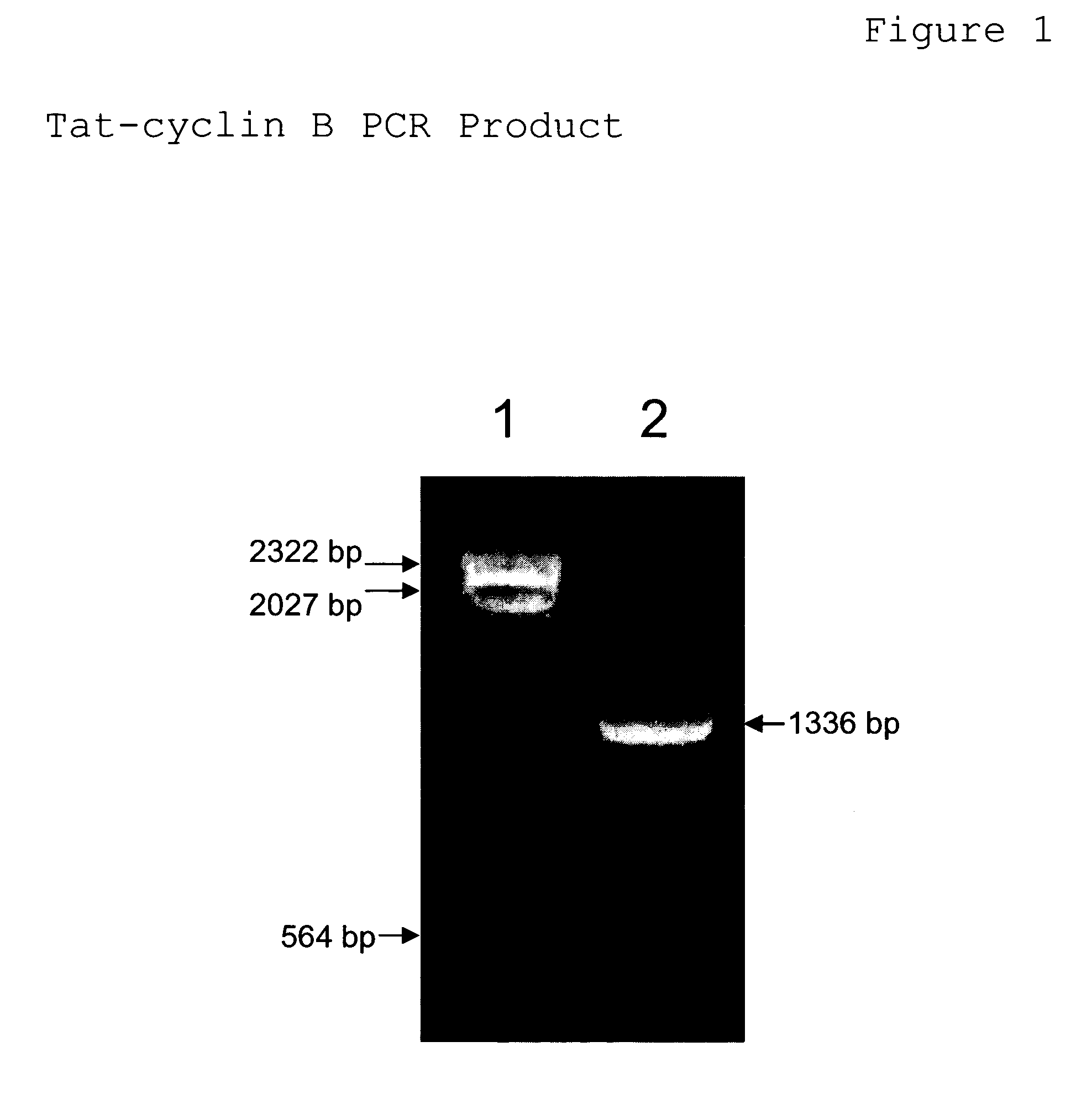Inhibitor of cell proliferation and methods of use thereof
a cell proliferation inhibitor and cell technology, applied in the field of recombinant polypeptides and polynucleotides, can solve the problems of uncontrolled cell proliferation, most benign hyperplasias, hyperplasias, etc., and the current treatment protocol for these diseases is generally toxic and/or ineffective as a permanent cur
- Summary
- Abstract
- Description
- Claims
- Application Information
AI Technical Summary
Benefits of technology
Problems solved by technology
Method used
Image
Examples
example 1
Production of Recombinant Tat-cyclin B
(a) Construction of the Tat-cyclin B Polynucleotide by Polymerase Chain Reaction
[0088]Oligonucleotide primers 5′TatclnB (SEQ ID NO:23) and 3′TatclnB (SEQ ID NO:24) are mixed together with a template DNA comprising cyclin B, then subjected to the polymerase chain reaction. The cyclin B template DNA was isolated from the bacterial IMAGE consortium clone no. 1499287. Oligonucleotide primer 5′TatclnB (SEQ ID NO. 23) is comprised of 25 HIV-1 Tat nucleotides (position 10–34), 21 cyclin B nucleotides from the 5′ end of the cyclin B gene (position 35–55), and an EcoRI restriction endonuclease site (position 5–9). The 3′TatclnB oligonucleotide primer is comprised of 22 nucleotides from the 3′ end of the cyclin B gene (position 13–34), and a NotI restriction endonuclease site (position 5–12). The PCR reaction mixture consisted of template DNA at 0.1 volume, each oligonucleotide primer at 0.5 μM, 25 mM TAPS (pH9.3), 50 mM KCl, 1 mM 2-mercaptoethanol, 2 mM ...
example 2
Expression and Isolation of Tat-cyclin B Peptide
[0091]pGAP-ZαA—Tat-cyclin B plasmid DNA was transformed into a strain of Pichia angusta (formerly Hansenula polymorpha). Transformation competent Pichia angusta cells were prepared according to the LiCl2 modification of the well known Lithium acetate yeast transformation method. See the handbook entitled “Pichia expression vectors for constitutive expression and purification of recombinant proteins”, version C, 2000, for additional details on the transformation methodology. Pichia angusta transformed with pGAP-ZαA—Tat-cyclin B plasmid DNA were plated onto yeast extract-peptone-dextrose (YPD)-agar containing Zeocin and colonies harboring the correct plasmid were selected via colony PCR, as described in example 1.
[0092]Transformed Pichia were grown in liquid YPD media to a cell density corresponding to an optical density at 600 nm of about 1.0 (±0.5). The cells were pelleted by centrifugation and the supernatant was filter sterilized thr...
example 3
Treatment of HELA Cells with Tat-cyclin B Peptide and Demonstration of Cell Cycle Arrest
[0094]HeLa cells (ATCC No. CCL-2)were maintained in standard HeLa cell media consisting of minimum essential medium Eagle with 2 mM L-glutamine and Earle's BSS adjusted to contain 1.5 g / L sodium bicarbonate, 0.1 mM non-essential amino acids, and 1.0 mM sodium pyruvate, 90%; fetal bovine serum, 10%; at 37° C. in an atmosphere of 5% CO2.
[0095]Adherent HeLa cells were harvested from the tissue culture plates by standard trypsin / EDTA treatment, washed in sterile PBS and resuspended in fresh growth media. 5×104 cells were plated onto each of 6, 100-mm tissue culture plates. Two cultures were incubated with 10 ml standard HeLa cell media plus 100 μl sterile YPD, two different cultures with 10 ml media plus 100 μl conditioned YPD media containing Tat-cyclin B and the final two cultures with 100 μl concentrated YPD media containing 10-fold concentrated Tat-cyclin B. Cells were grown for approximately fou...
PUM
| Property | Measurement | Unit |
|---|---|---|
| optical density | aaaaa | aaaaa |
| lipid soluble | aaaaa | aaaaa |
| urine flow rate | aaaaa | aaaaa |
Abstract
Description
Claims
Application Information
 Login to View More
Login to View More - R&D
- Intellectual Property
- Life Sciences
- Materials
- Tech Scout
- Unparalleled Data Quality
- Higher Quality Content
- 60% Fewer Hallucinations
Browse by: Latest US Patents, China's latest patents, Technical Efficacy Thesaurus, Application Domain, Technology Topic, Popular Technical Reports.
© 2025 PatSnap. All rights reserved.Legal|Privacy policy|Modern Slavery Act Transparency Statement|Sitemap|About US| Contact US: help@patsnap.com


